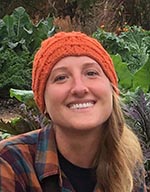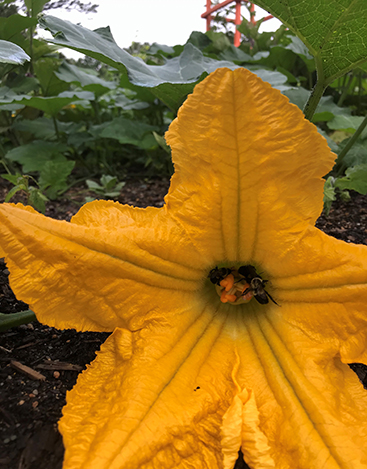Garden Talk
Horticultural Highlight: Winter Squash ‘Autumn Frost’

In this series, the staff of Duke Gardens highlights plants you’ll find within our 55-acre living collection. This week Doris Duke Center Gardens horticulturist Lindsey Luks features one of her favorite winter squashes, including a recipe!
Botanical name: Cucurbita moschata ‘Autumn Frost’
Common name: Winter Squash
Family name: Cucurbitaceae (Cucumber Family)
Plant type: Summer annual
Location in Duke Gardens: Charlotte Brody Discovery Garden

Do you love butternut squash but dream of a smaller variety so you don’t have to eat it for a whole week straight? ‘Autumn Frost’ is a newly available selection that is everything you could ask for. The tidy vines ramble through the garden with beautiful deep green, disease resistant leaves, which make a perfect living mulch for taller plants, such as zinnias, eggplants and tomatoes. A living mulch is a plant that covers the ground, keeping the soil cooler and moist, and shading out weeds that might otherwise compete with the plants you want in the garden.
Once the vines start producing flowers, they continue until frost. The extra-large golden yellow flowers make a wonderful food source for both native and honey bees, and oftentimes in the early morning you can find multiple bumblebees sleeping inside the flowers. The fruits begin as tiny green squashes, with the flowers still attached, and they ripen over the course of several weeks. Fruits are ready to harvest when they turn from green to a pale orange-blue and the stem connecting the fruit to the plant begins to turn brown. This variety is called ‘Autumn Frost’ because of the gorgeous blue waxy coating to the rind, which gives this squash a frostbitten hue.
Fruits are smaller, typically weighing around 3 to 4 pounds, meaning one squash is perfect for two people without leftovers! Seeds can also be roasted and eaten as a snack the next day. The flesh can be made into breads, pies, soups and more. One plant may yield as many as 40 squashes, which can be kept inside in a cool, dry, dark place for up to five months.
Recipe for Simple Roasted Butternut Squash:
Wash the exterior of the squash, and dry it well. Slice into quarters, removing the stem. Remove seeds and save for roasting. Place quarters cut side up on an aluminum foil lined pan. Drizzle with olive oil and place in a preheated 350-degree oven. Roast until the flesh is fork-tender and the edges have begun to brown and caramelize. Cooking time varies with size of squash. Top with your choice of butter, cinnamon, maple syrup or salt and pepper.
Photos by Lindsey Luks.






